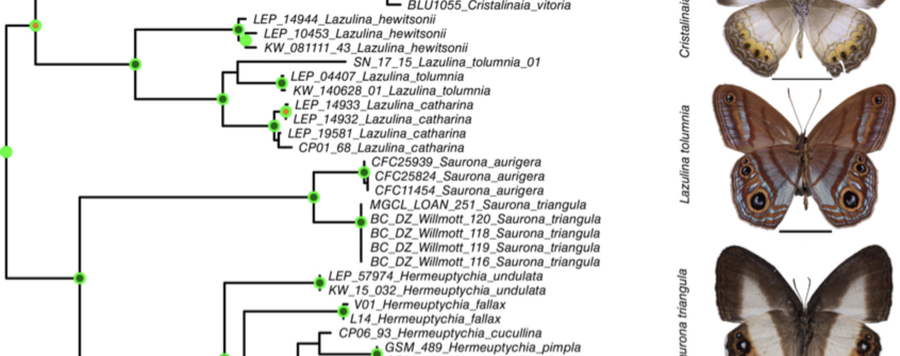
Combining target enrichment and Sanger sequencing data to clarify the systematics of the diverse Neotropical butterfly subtribe Euptychiina (Nymphalidae, Satyrinae)
The diverse, largely Neotropical subtribe Euptychiina is widely regarded as one of the most taxonomically challenging groups among all butterflies. Over the last two decades, morphological and molecular studies have revealed widespread paraphyly and polyphyly among genera, and a comprehensive, robust phylogenetic hypothesis is needed to build a firm generic classification to support ongoing taxonomic revisions at the species level. Here, we generated a dataset that includes sequences for up to nine nuclear genes and the mitochondrial COI ‘barcode’ for a total of 1280 specimens representing 449 described and undescribed species of Euptychiina and 39 out-groups, resulting in the most complete phylogeny for the subtribe to date. In combination with a recently developed genomic backbone tree, this dataset resulted in a topology with strong support for most branches. We recognize eight major clades that each contain two or more genera, together containing all but seven Euptychiina genera. We provide a summary of the taxonomy, diversity and natural history of each clade, and discuss taxonomic changes implied by the phylogenetic results. We describe nine new genera to accommodate 38 described species: Lazulina Willmott, Nakahara & Espeland, gen.n., Saurona Huertas & Willmott, gen.n., Argentaria Huertas & Willmott, gen.n., Taguaiba Freitas, Zacca & Siewert, gen.n., Xenovena Marín & Nakahara, gen.n., Deltaya Willmott, Nakahara & Espeland, gen.n., Modica Zacca, Casagrande & Willmott, gen.n., Occulta Nakahara & Willmott, gen.n., and Trico Nakahara & Espeland, gen.n. We also synonymize Nubila Viloria, Andrade & Henao, 2019 (syn.n.) with Splendeuptychia Forster, 1964, Macrocissia Viloria, Le Crom & Andrade, 2019 (syn.n.) with Satyrotaygetis Forster, 1964, and RudyphthimoidesViloria, 2022 (syn.n.) with Malaveria Viloria & Benmesbah, 2020. Overall, we revised the generic placement of 79 species (74 new generic combinations and five revised combinations), and as a result all but six described species of Euptychiina are accommodated within 70 named, monophyletic genera. For all newly described genera, we provide illustrations of representative species, drawings of wing venation and male and (where possible) female genitalia, and distribution maps, and summarize the natural history of the genus. For three new monotypic genera, Occulta gen.n., Trico gen.n. and Xenovena gen.n. we provide a taxonomic revision with a review of the taxonomy of each species and data from examined specimens. We provide a revised synonymic list for Euptychiina containing 460 valid described species, 53 subspecies and 255 synonyms, including several new synonyms and reinstated species.





